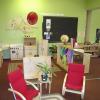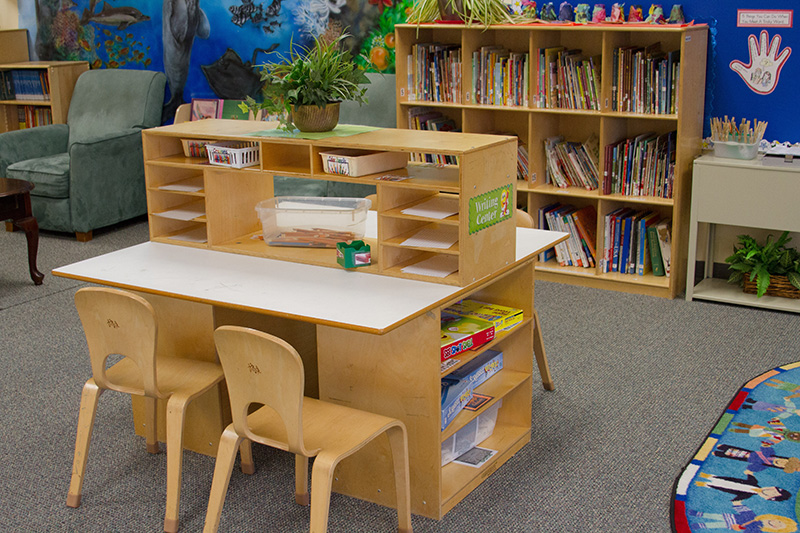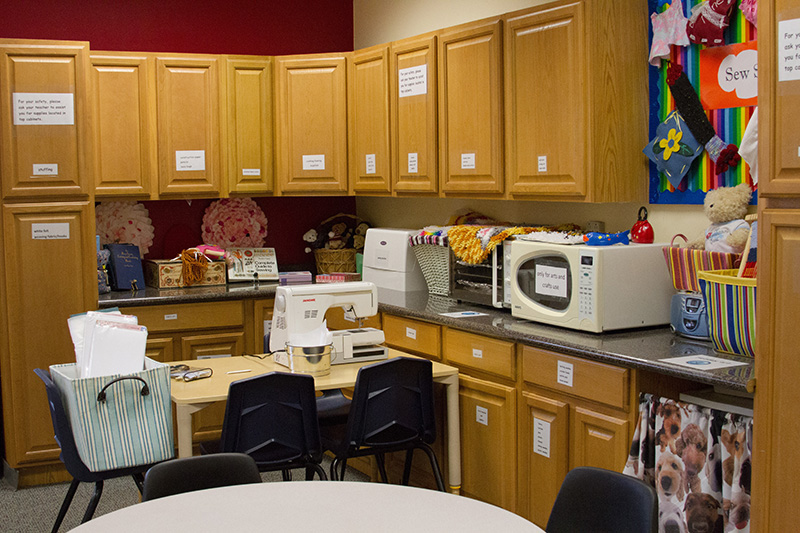- Recognize the effects of the learning environment on school-age children and youth.
- Identify common features of the environment that help children and youth feel secure, comfortable, welcome, and ready to explore and learn.
- Describe how to design and maintain a developmentally appropriate environment for school-age children.
- Define common activity areas and important elements found in effective room design for school-age environments.
Learn
Know
How Do Environments Affect You?
When you visit a favorite restaurant, a local park, a sporting arena, or a good friend’s home, you likely feel good about these experiences because you enjoy them. What about these places makes you feel welcome or secure? What makes you want to go back? You may be thinking about the people with and around you, the color of a room, whether or not there is sunlight, what you smell or hear, the furniture and accessories, or the temperature.
Now think about places you don’t like to go. Environments like the dentist’s office, a crowded airport, or a noisy restaurant. What about these environments makes them less pleasant for you?
In some settings, we feel relaxed and comfortable, and in others we feel tense, overwhelmed, and confused. Environments can affect us in many different ways. They can influence how we feel, what we do, and the ways we respond in certain situations. Some of us dislike places where we feel that we cannot control or predict our experiences. In some spaces, we may feel like we do not belong or are not appreciated.
Just like adults, school-age children and youth are affected by their environments. We can ensure that classrooms and other learning spaces for school-age children make them feel welcome, secure, and ready to learn.
Designing Your Space to Meet School-Age Children’s Needs
Creating a supportive learning environment involves time, reflection, and planning. Whether school-age children are in your program for three hours a day after school or twelve hours a day during the summer, the environment plays a major role in helping them develop and learn. Research suggests that a high-quality, after-school environment can help school-age children’s social skills, learning motivation, academic achievement, and it can lower levels of obesity (Durlak, Mahoney, Bohnert & Parente, 2010). Military children are a special group that may experience a great deal of change in their daily lives, and your supportive classroom can be an important source of consistency for them. You must also consider each individual child’s background, experiences, interests, and abilities as you design your program space. A supportive environment is:
- Well organized: orderly, planned, and safe
- Dependable: a stable “home base” for children who need it
- Flexible: able to adjust to meet the needs of all children
- Enriching: full of engaging experiences
Supportive environments can send children and youth a variety of positive messages about their learning (Dodge et al., 2016), such as:
- This is a good place to be.
- You belong here.
- This is a place you can trust.
- There are places where you can be by yourself when you want to.
- You can do many things on your own here.
- This is a safe place to explore and try out your ideas.
Environments not only impact how we feel and give us messages about how to act, but they can also impact what we learn. The Reggio Emilia approach to early childhood education recognizes the tremendous impact of the environment by referring to it as the “third teacher” (with parents and teachers as children’s first and second teachers). The Reggio Emilia approach was developed by Loris Malaguzzi and named after an area in Italy. This approach demonstrates that children are powerful learners, and that their interests should guide adults’ decisions surrounding learning, including how the environment is arranged and the materials provided. The Reggio Emilia approach believes that the learning environment plays a critical role in children’s development, and that the intentionality of teachers in the design of spaces and their selection and arrangement of materials, significantly influences children’s level of engagement and learning (Edwards, 2002). We will revisit this approach to early childhood education in future lessons in this course.
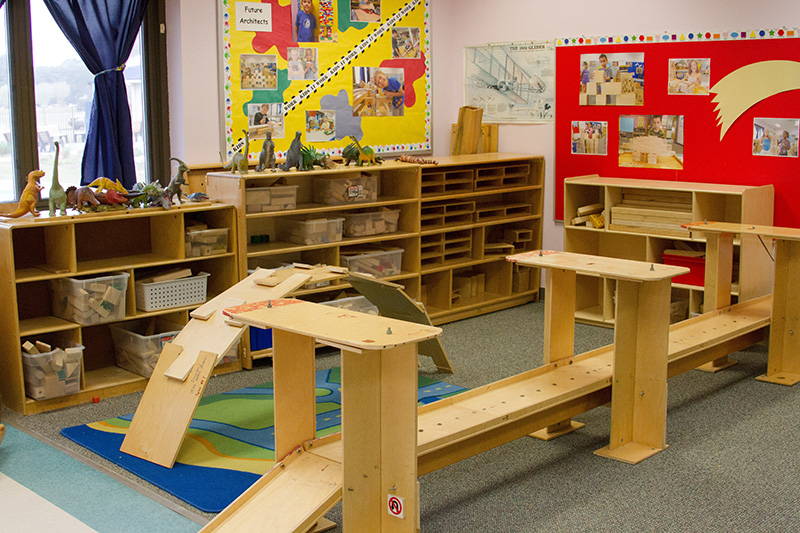
Places for Play and Learning: Activity Areas
When you walk into a retail or grocery store, how do you find what you need? If you are looking for grapes, you probably feel confident that you can find them with other fresh fruits and vegetables. If you want to find a new pair of socks, you probably have a good idea about where to look. Many retail establishments make the most out of simple design principles: objects with similar uses are stored near each other, and there are signs to guide you.
Now think about a child or youth in your school-age program. How does the child or youth know where to find toys and materials? How do these individuals use the environment to make decisions?
There are many differences between retail establishments and child and youth programs, but organizing materials by their purpose makes sense in both environments. In stores, we might call these groups of similar items “departments.” In environments for school-age children or youth, we use the terms “activity areas” or “learning centers” to describe spaces that are designed for certain purposes or that hold materials with similar uses.
When a school-age child enters a well-designed activity area, the individual knows the:
- Materials that can be found there
- Type of play (loud, quiet, social, solitary) that may happen there
- Expectations for how to behave there
- Ways to explore, learn, and have fun there
As a school-age staff member, you design learning opportunities for children every day, and your indoor or outdoor environment sets the stage for most of these opportunities. Activity areas are key tools for learning in school-age environments. You can use children’s and youth’s interests, goals, and abilities to design your activity areas.
Some important activity areas and corresponding developmentally appropriate materials include:
Depending on the age-range in your school-age program, and especially if you have kindergarten or early elementary school children, consider adding a space for dressing up and pretend play. It may be useful to have a dramatic play activity area that includes various props to take on different characters or materials that support pretend play in a flexible way (e.g., the space can be a family home, a restaurant, or a dentist’s office). Depending on how you design this space, this activity area could also be a space for exploring theater, where older children could experiment with enacting real plays or life scenarios.
Keep in mind that, depending on your physical space, these activity areas could all be within one large classroom or spread out over different spaces in your program. The key is making sure there is logic behind the placement of different activity areas and that children and youth know where the various activities are and what the rules are for accessing them (e.g., the “music and movement” area in the gymnasium will open at 3:30, once a staff member is there). In many school-age programs, children and youth use an activity management system—tags, pictures, or symbols used to limit the number of children who play in an activity area and help staff keep track of where children are. We will address this more in Lesson Five.
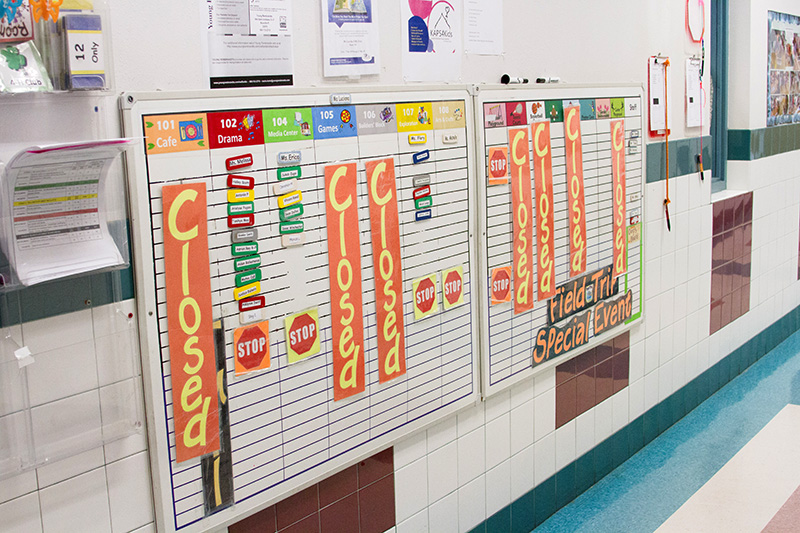
Promote a Feeling of Ownership
School-age children and youth should be given the opportunity to help design and organize their environment. Allowing children and youth to choose materials will give them a sense of pride and ownership. When children and youth feel a sense of ownership of their learning space, they are more likely to respect the space and feel a greater responsibility to take care of it.
Children and youth feel that they are an important part of your program when they see elements from their lives throughout the learning space. Hang children’s artwork in inexpensive frames and display photos of children and youth with their peers or families. You can further promote ownership by including elements in the classroom from children’s homes (e.g., asking families to donate décor or pictures that reflect their background). Doing so allows teachers and children to recognize the various backgrounds that are represented in your program.
It is important to acknowledge all children and families in your program and to encourage them to share information about their backgrounds. Invite parents to bring unique materials or to share with the children and youth of your program. Encourage children to explore others’ backgrounds in a respectful manner. You may have school-age children and youth from all over the world or children and youth who have traveled abroad with their military families. Value their experiences and knowledge by having them reflected in your learning environment.
See
School-age learning environments look different from each other depending on the program. The following video provides examples of safe and organized learning environments that meet the interests and needs of school-age children and youth. It highlights activity areas to consider in the development of your school-age program.
Learning Environments: An Introduction
Do
There are many ideas about how to arrange school-age environments. However, some important elements found in every effective room design include:
- Clear boundaries: Use shelves, furniture, or other barriers to help children and youth focus and understand the intended use of the space. Large, open areas encourage running and roughhousing. Arrange your furniture and activity areas to break up large, open spaces.
- Clear ways to enter and exit: Help children and youth know how and where to come into an activity area. If you use an activity management system, make sure children and youth know how to use it. For example, do they need to travel with a staff member to activity areas located in different parts of the building?
- Sufficient materials: As much as possible, have duplicates of favorite materials. Also make sure there are enough materials so several children can play in social areas, like the toy and games area. Children are more likely to have meaningful play interactions if there are enough materials to use together.
- Engaging materials that spark children’s interests: Think about what children and youth in your program enjoy. Add materials or rotate materials regularly so children have new experiences. Think about the pictures, displays, print, or writing materials that can support children’s learning and engagement in each area. We will discuss this more in the lessons in this section.
- Separate loud and active areas from quiet and calm areas: Examples of quiet activity areas are the library, art, or writing centers. Loud, active areas might include toys and games or dramatic play.
- Access to needed materials: Discovery and science, and art spaces should have easy access to sinks. Technology would need access to electrical outlets. Soft carpeting in the library and the toys and games area can make it easier for children to sit and interact with materials on the floor.
- Learning Objectives: Align materials and interest areas to learning objectives.
- Comfort and safety: Observe children and youth to ensure that all equipment and furniture comfortably fits their needs. School-age children and youth can range greatly in age and size, so it is likely you will need a variety of furniture sizes available. Implement your program’s safety requirements. Always model healthy behaviors and lifestyle choices to children and youth.
Completing This Course
For more information on what to expect in this course, for the Learning Environments Competency Reflection, and for a list of the accompanying Learn, Explore and Apply resources and activities offered throughout the lessons, visit the School-Age Learning Environments Course Guide.
Please note the References & Resources section at the end of each lesson outlines reference sources and resources to find additional information on the topics covered. As you complete lessons, you are not expected to review all the online references available. However, you are welcome to explore the resources further if you have interest, or at the request of your trainer, coach, or administrator.
Explore
Think about how environments affect you and the children and youth in your care. In the Environments Affect Behavior activity, answer the questions about each space in your learning environment. Then share your responses with a trainer, coach, or administrator. Finally, compare your answers to the suggested responses.
Apply
To ensure your environment is designed to offer children and youth valuable learning experiences, use this inventory to help evaluate your own activity areas. Complete the Activity Area Inventory. Walk around your own space and talk about your observations with a trainer, coach, or administrator.
Glossary
Demonstrate
Biermeier, M. A., (2015). Inspired by Reggio Emilia: Emergent curriculum in relationship-driven learning environments. Young Children, 70 (5). https://www.naeyc.org/resources/pubs/yc/nov2015/emergent-curriculum
Council on Accreditation. (2018). Standards for child and youth development. Out-of-school time (CYD-OST). Council on Accreditation. https://coanet.org/standard/cyd-ost/
Dodge, D. T., Heroman, C., Berke, K., Bickart, T., Colker, L., Jones, C., Copley, J., & Dighe, J. (2016). The creative curriculum for preschool (6th ed.). Teaching Strategies.
Durlack, J. A., Mahoney, J. L., Bohnert, A. M., Parente, M. E. (2010). Developing and improving after-school programs to enhance youth’s personal growth and adjustment: A special issue of AJCP. American Journal of Community Psychology, 45, 285-293.
National Association for the Education of Young Children. (2009). Where we stand on responding to linguistic and cultural diversity. NAEYC.
Partnership for 21st Century Skills. (2009). Learning environments: A 21st century skills implementation guide. https://files.eric.ed.gov/fulltext/ED519459.pdf
Schaefer, R. (2016). Teacher inquiry on the influence of materials on children’s learning (Voices). Young Children 71 (5). https://www.naeyc.org/resources/pubs/yc/nov2016/teacher-inquiry-materials


